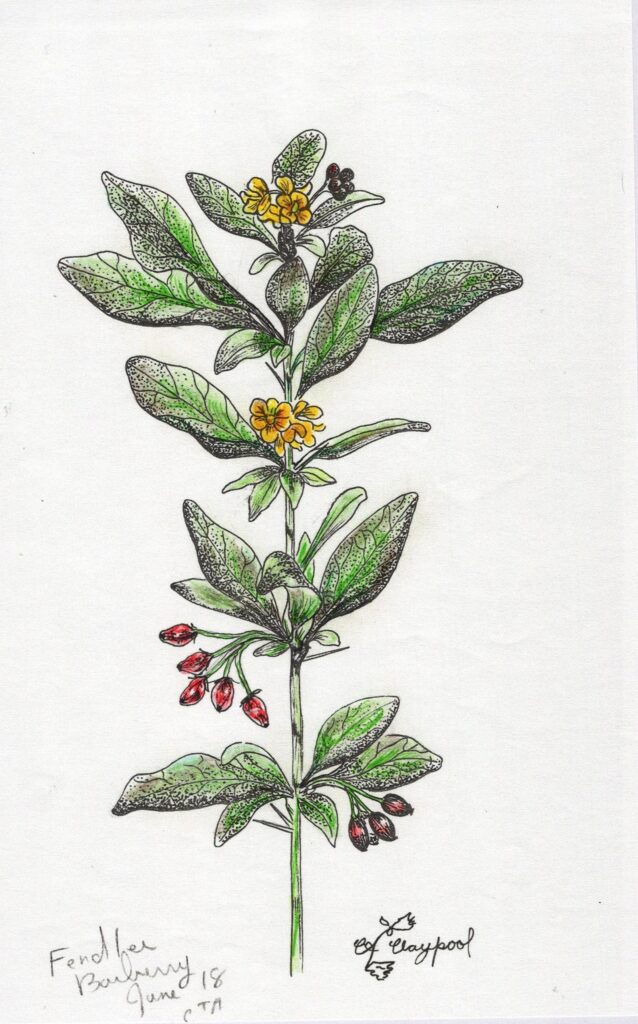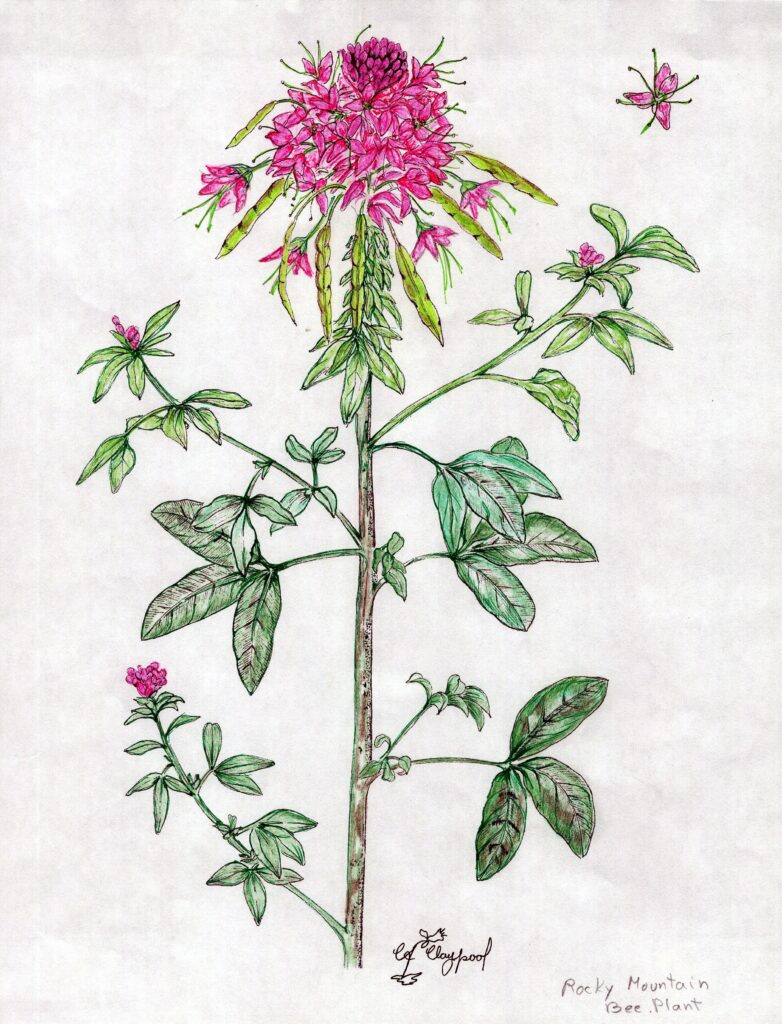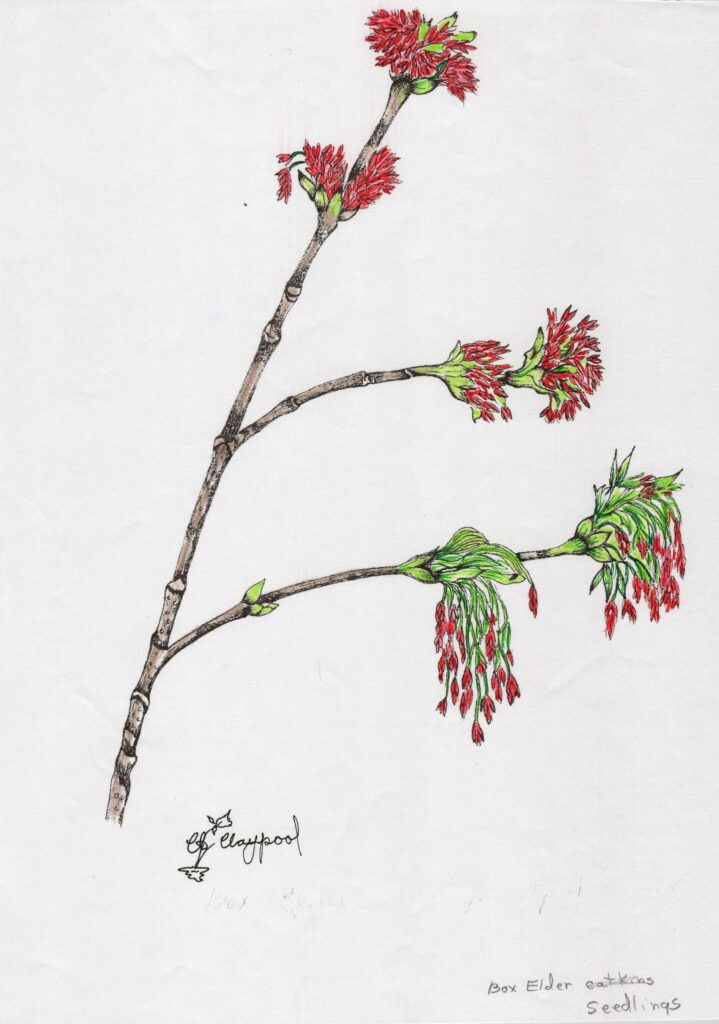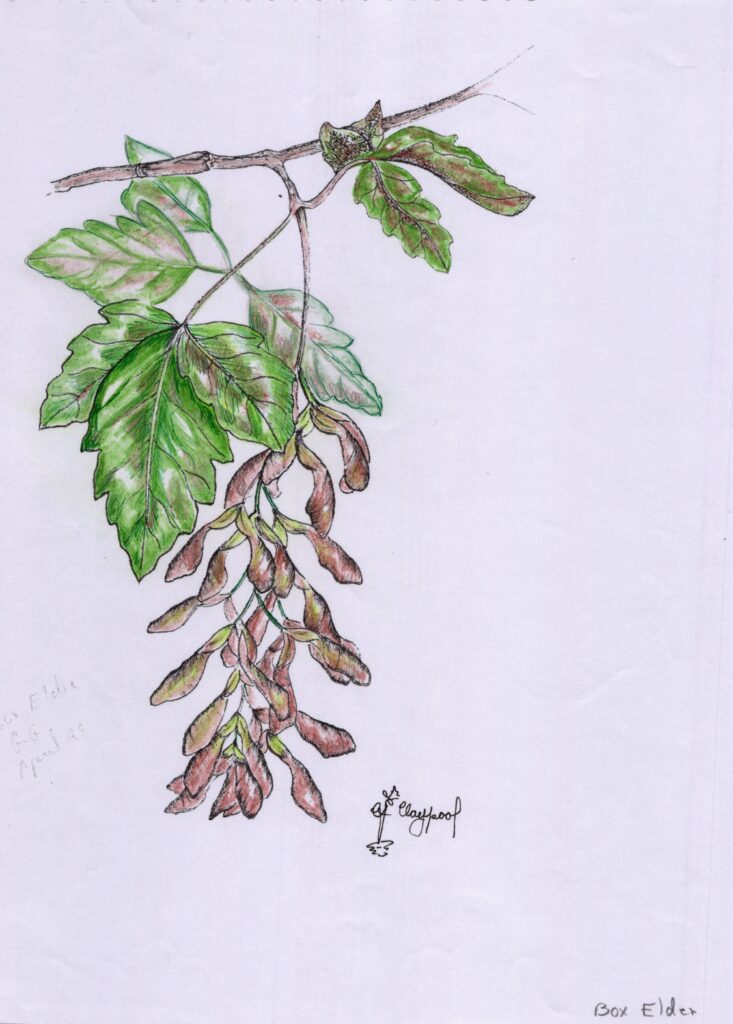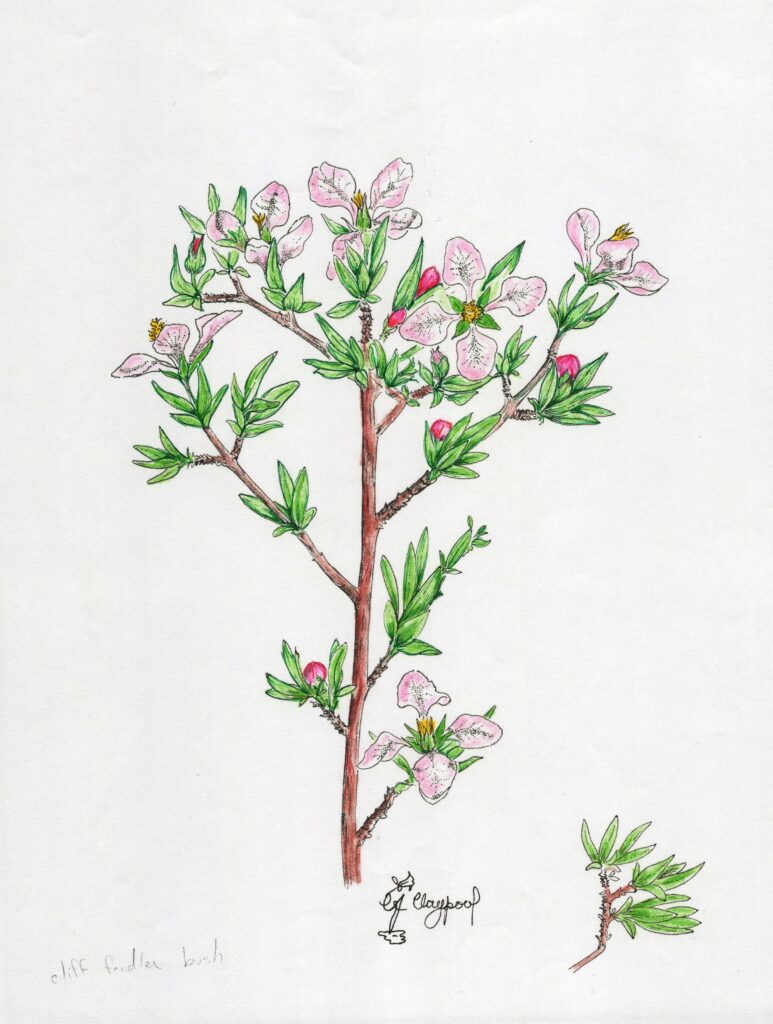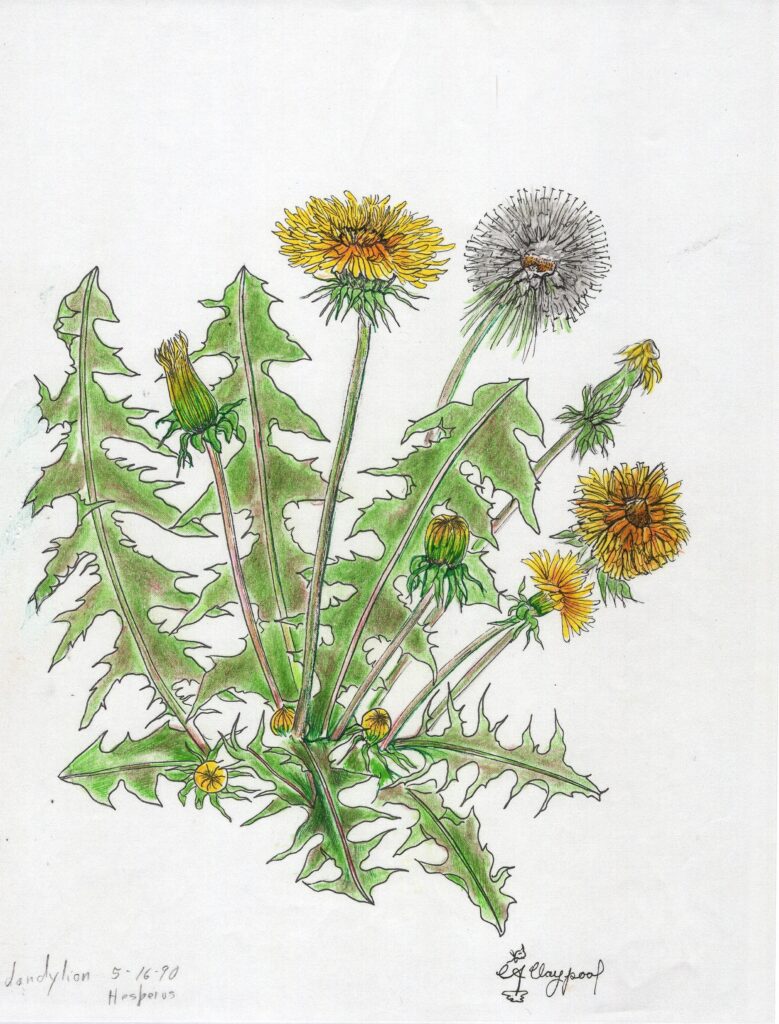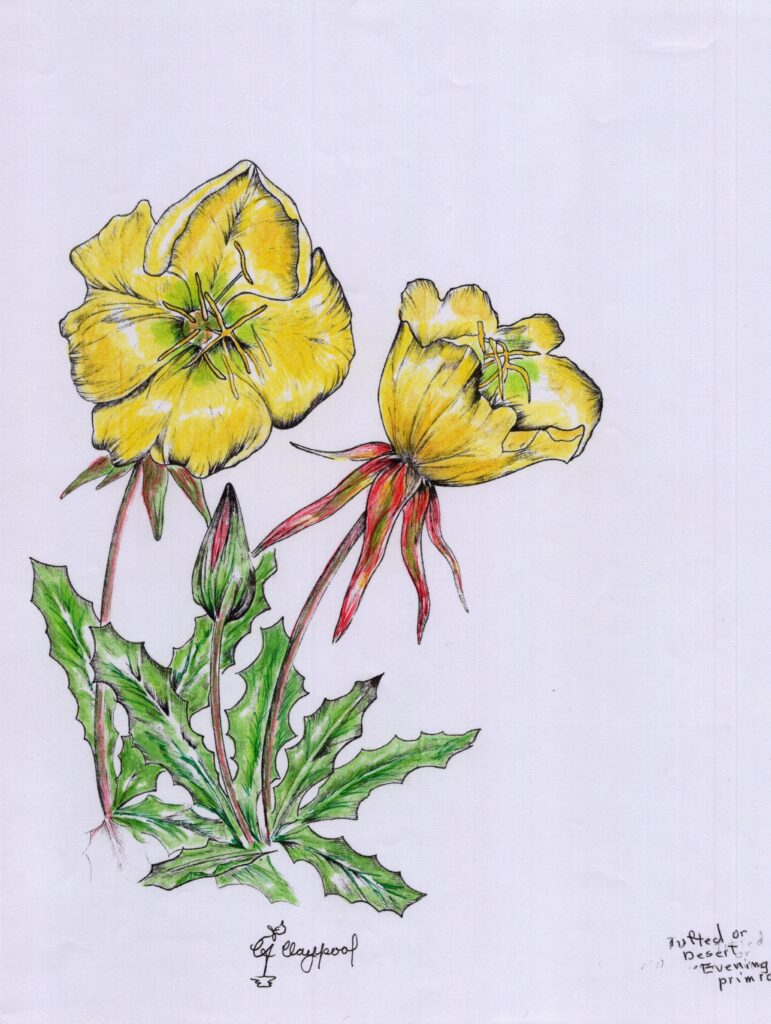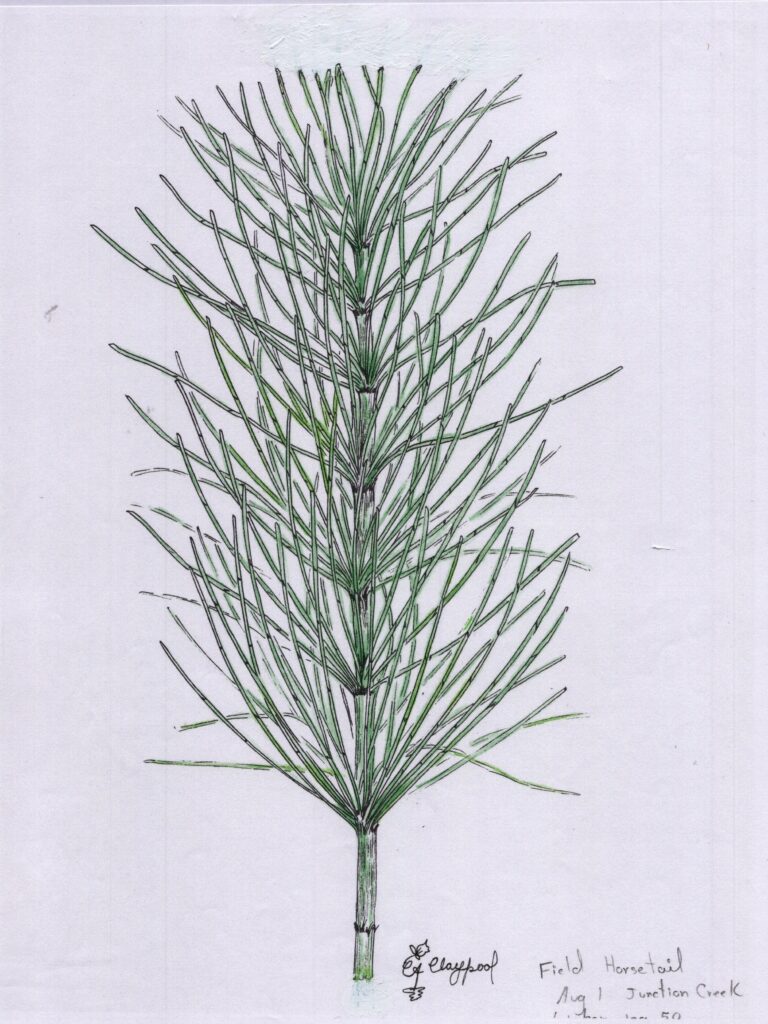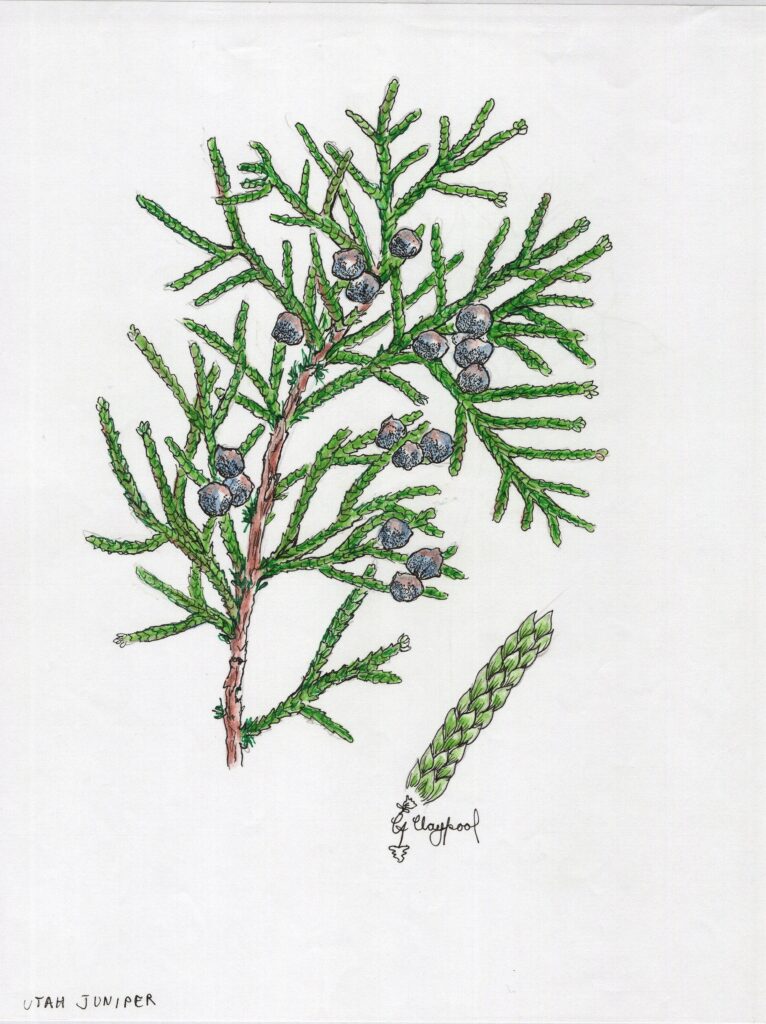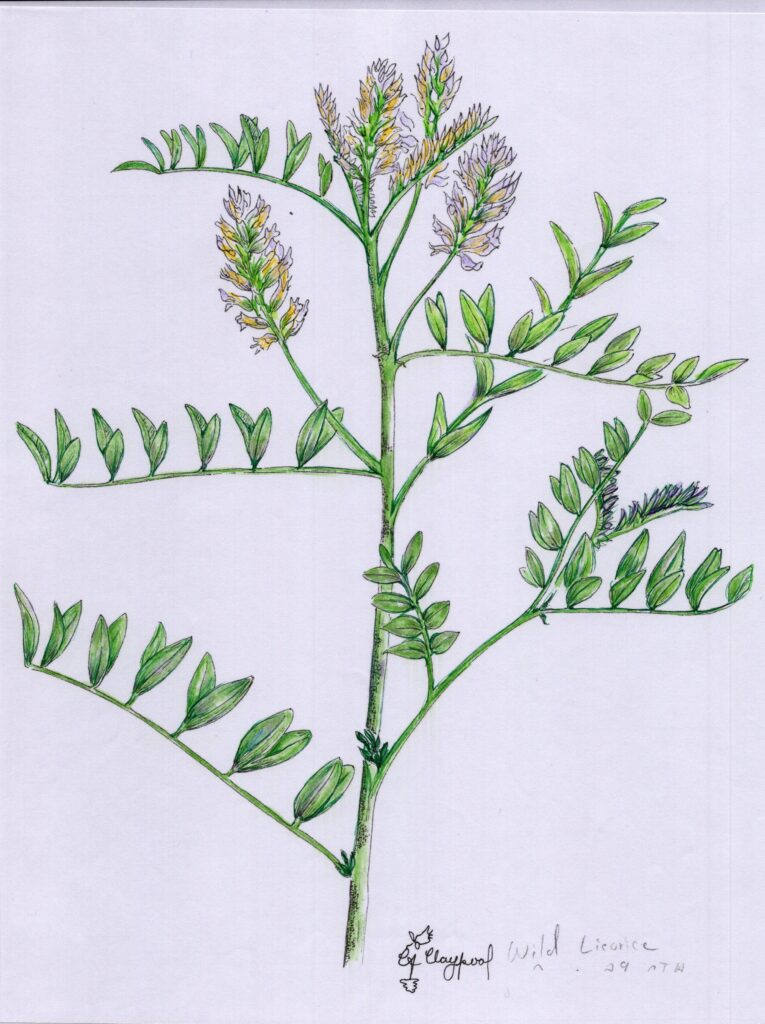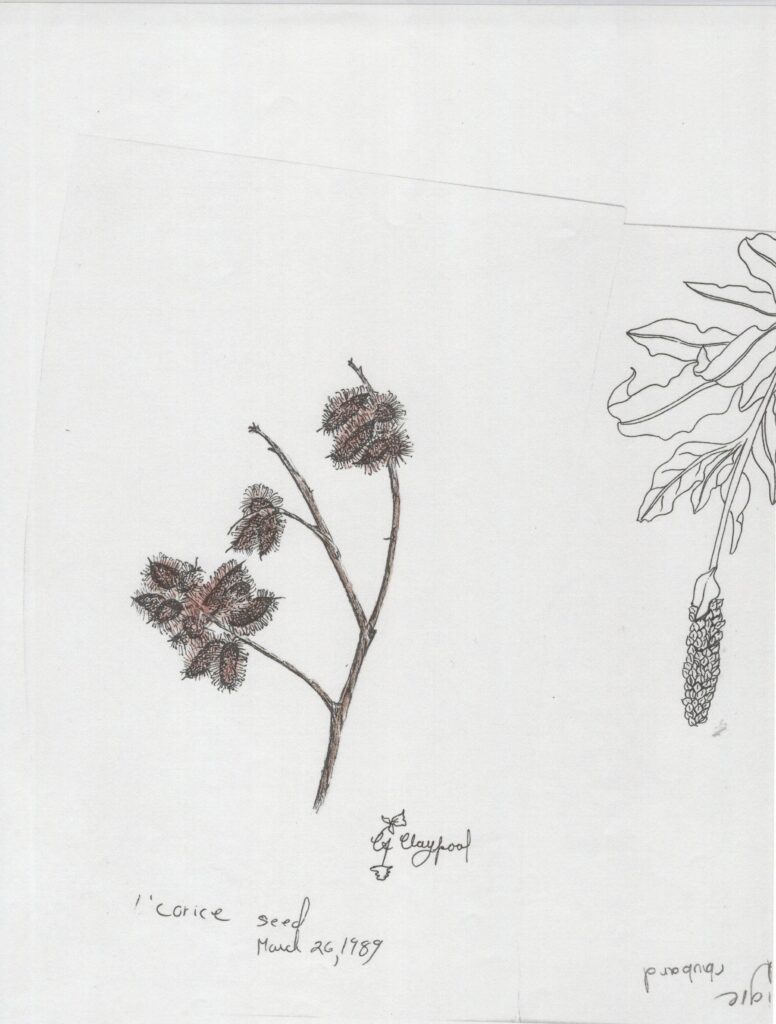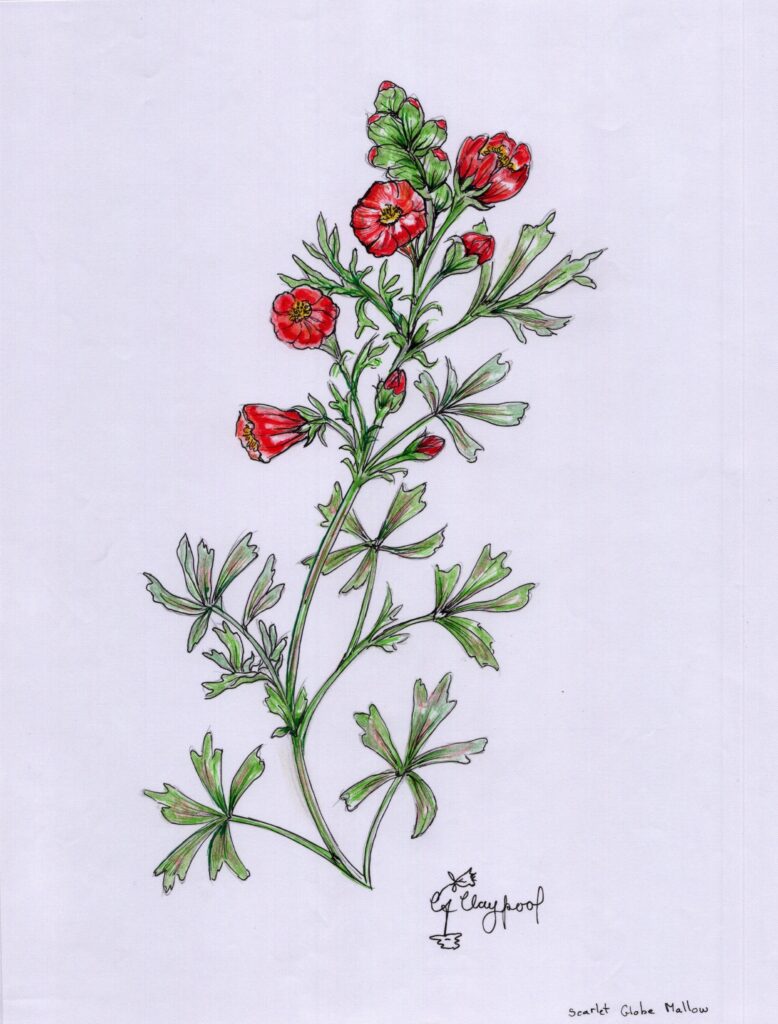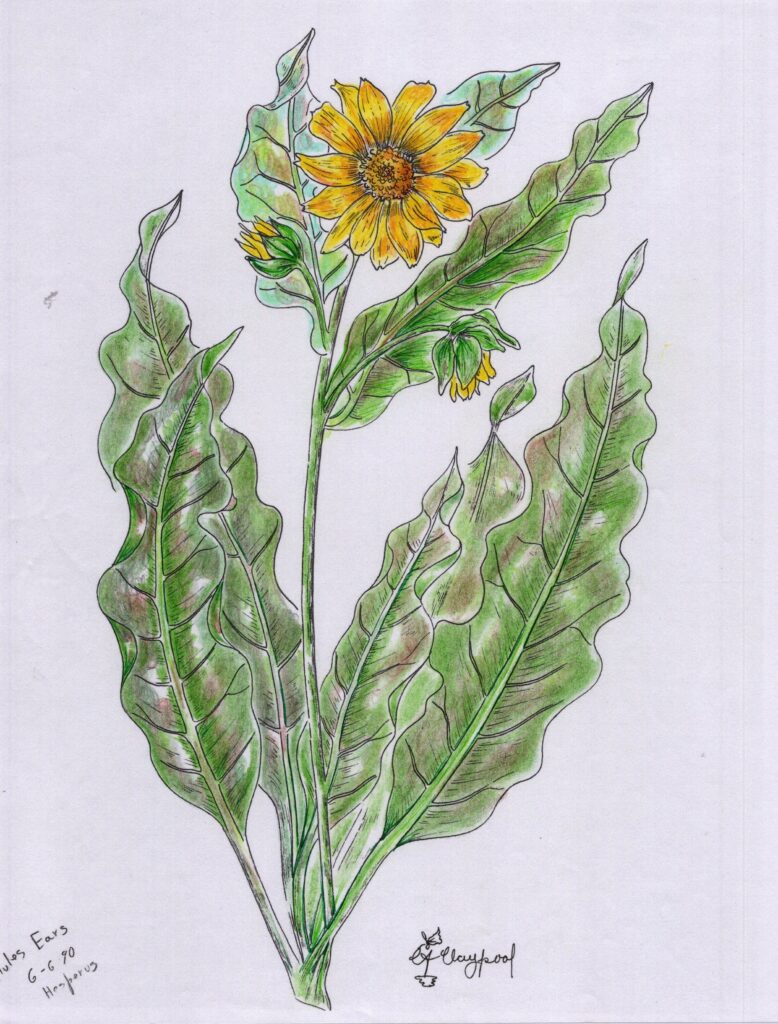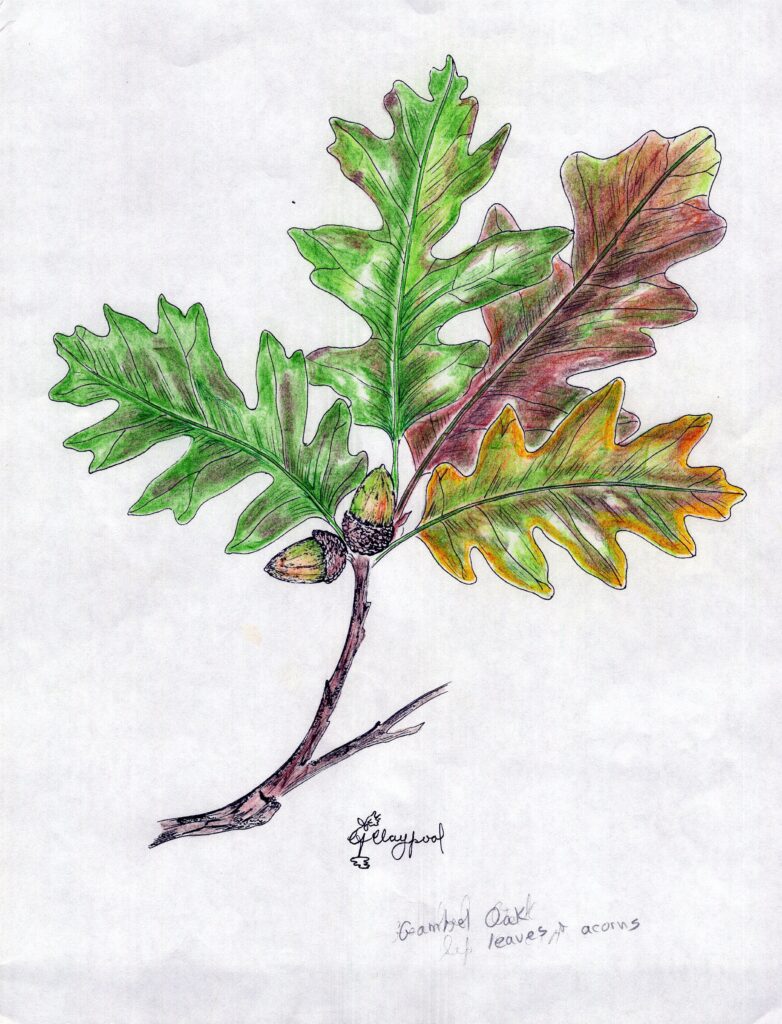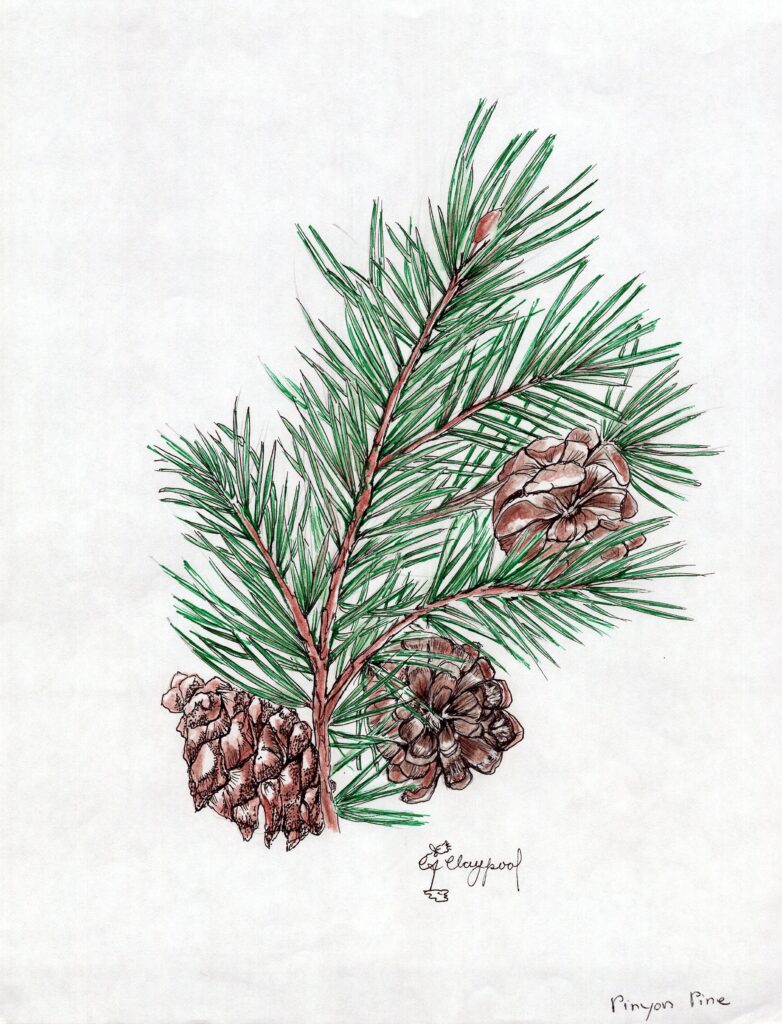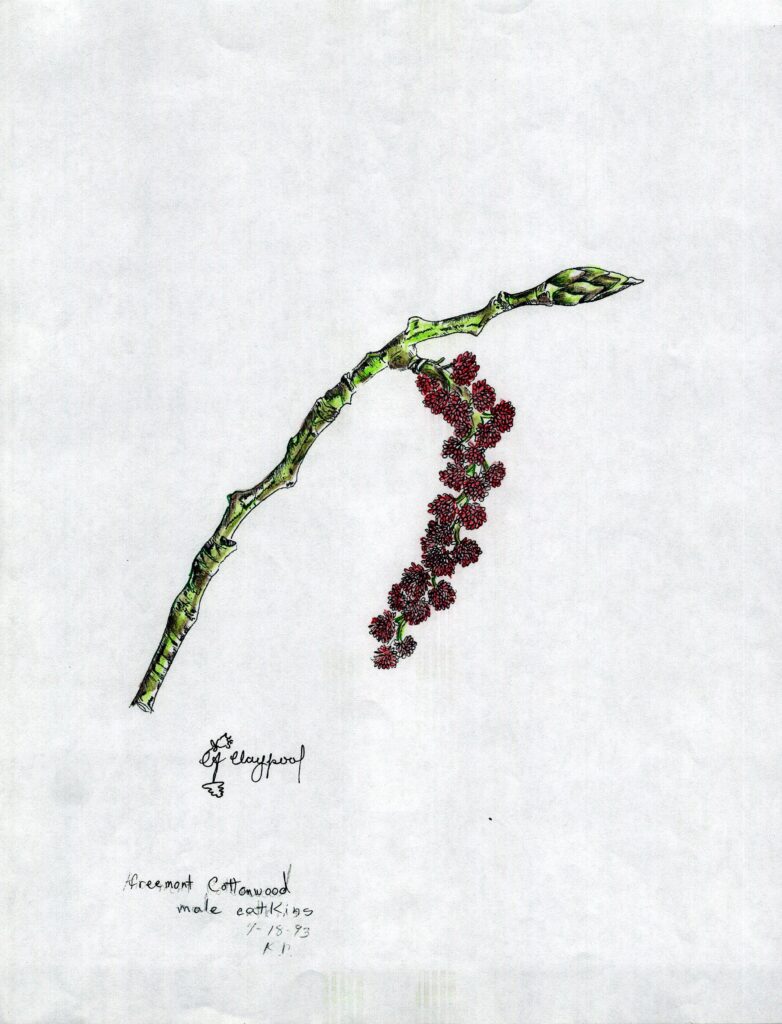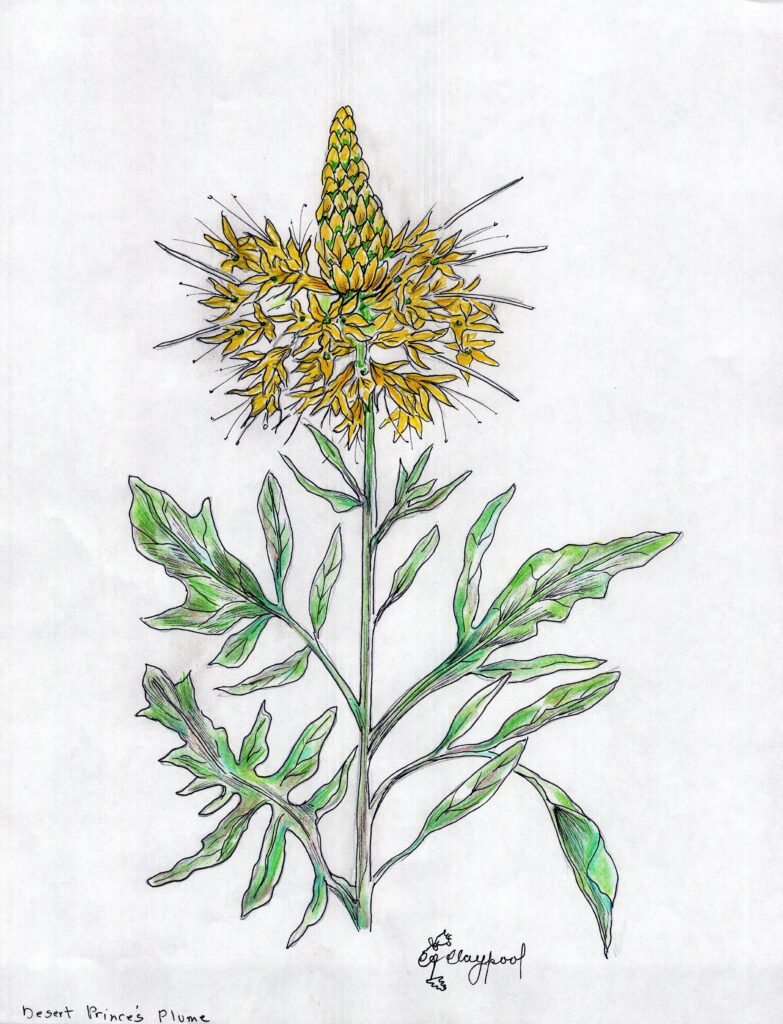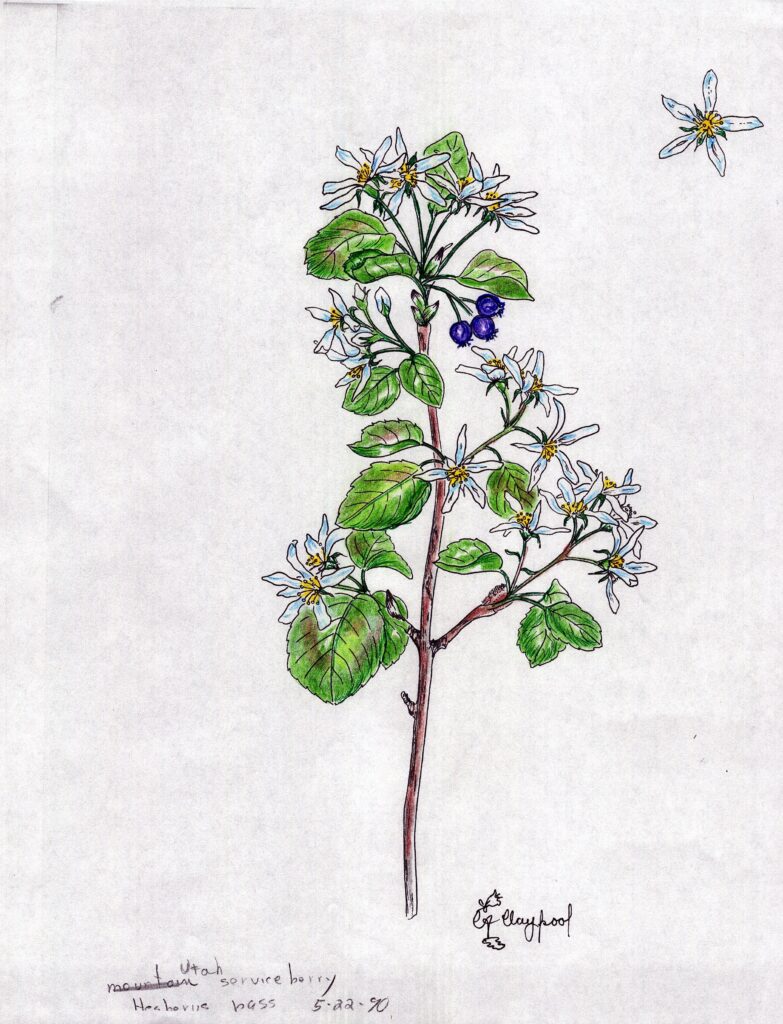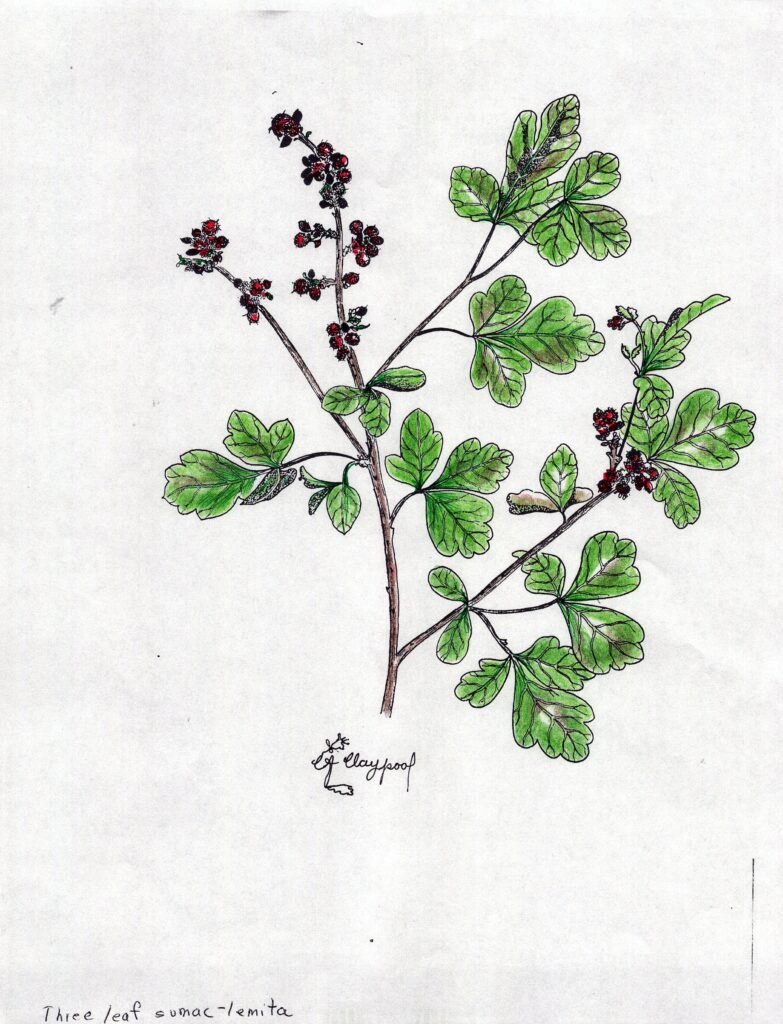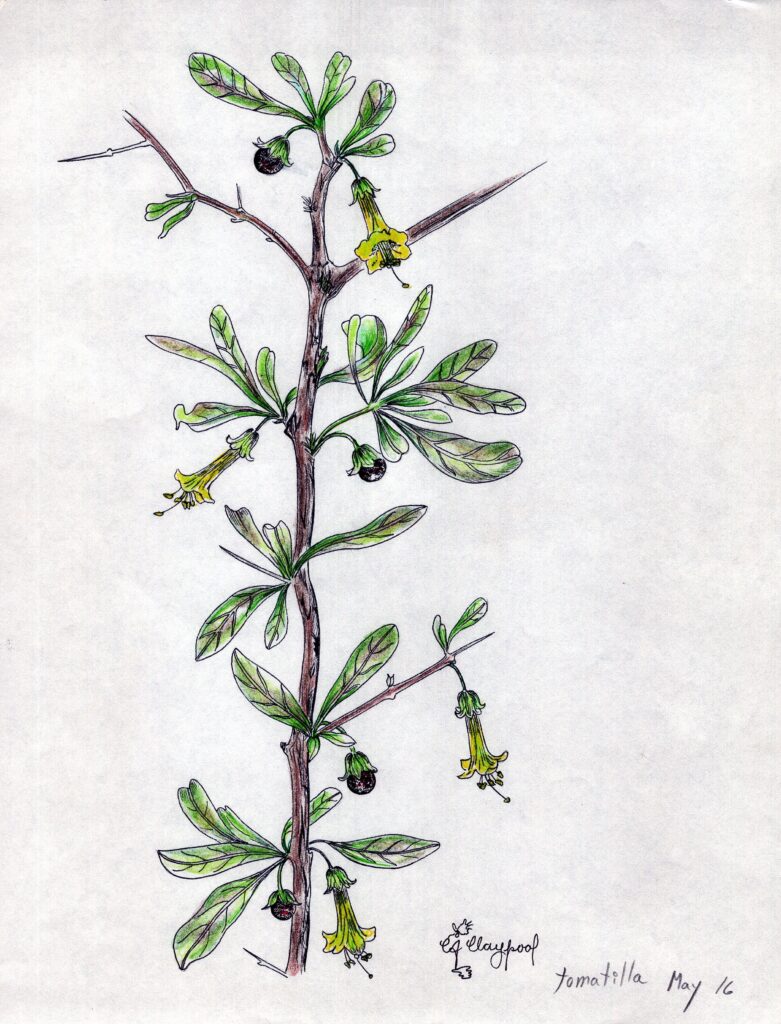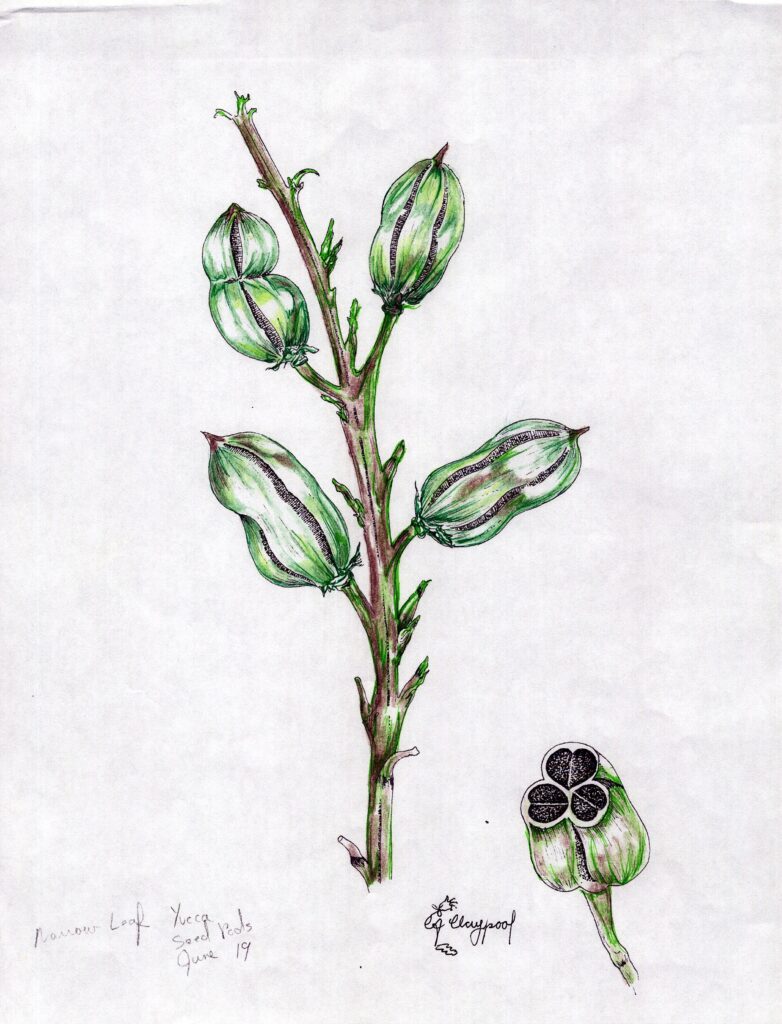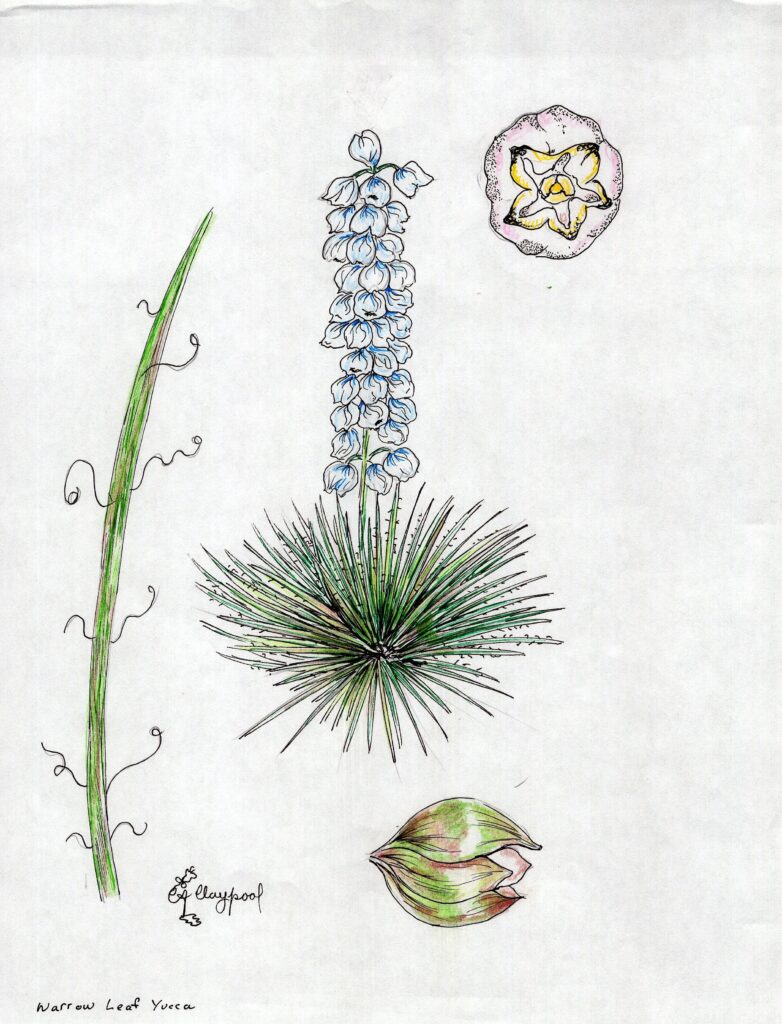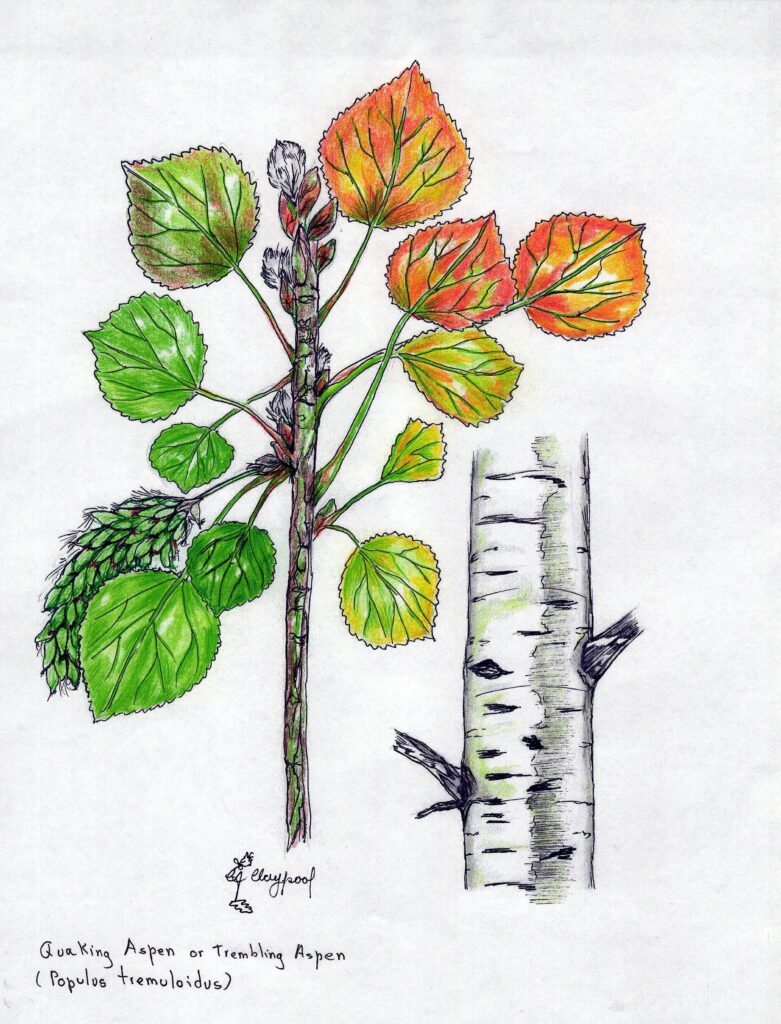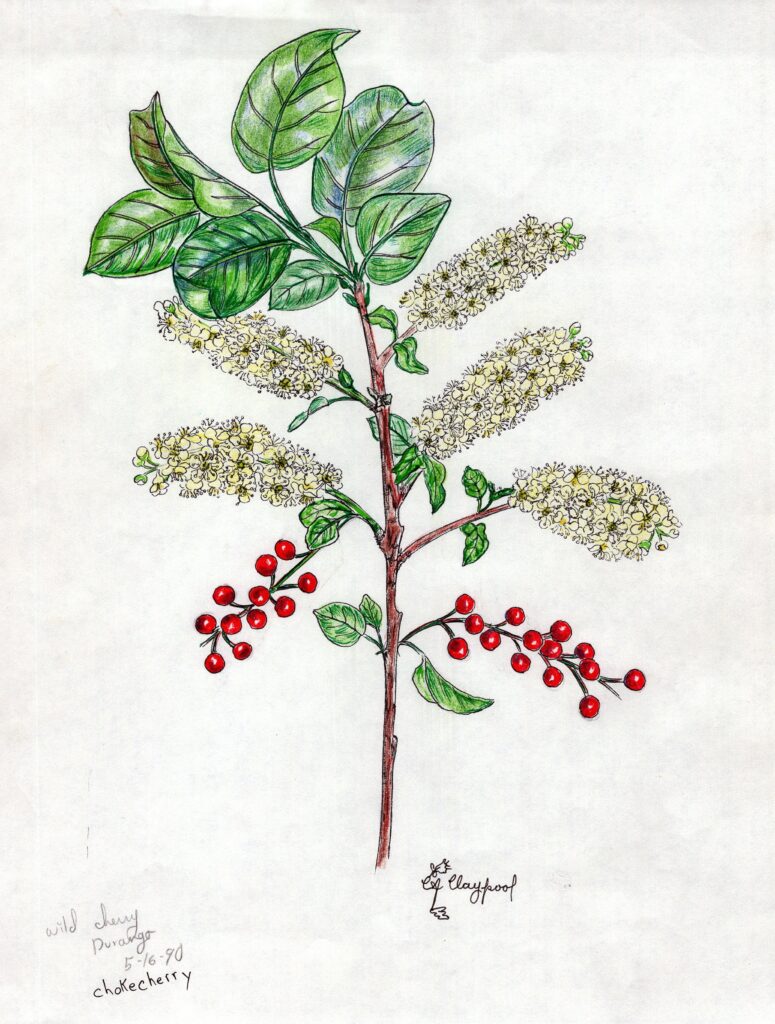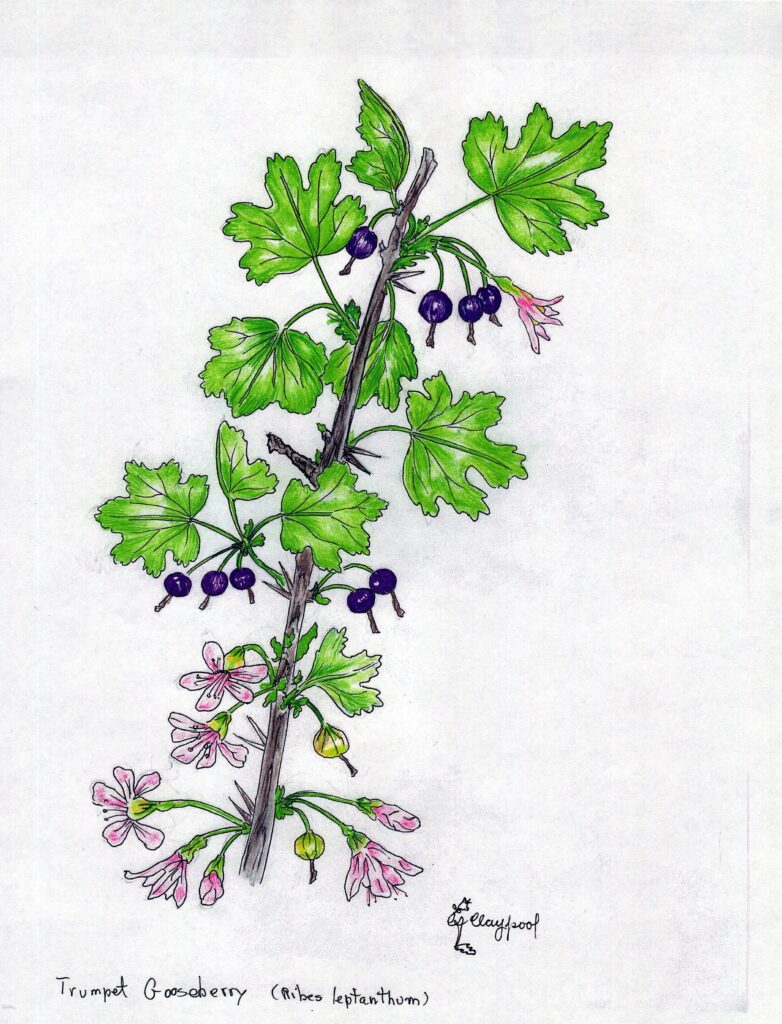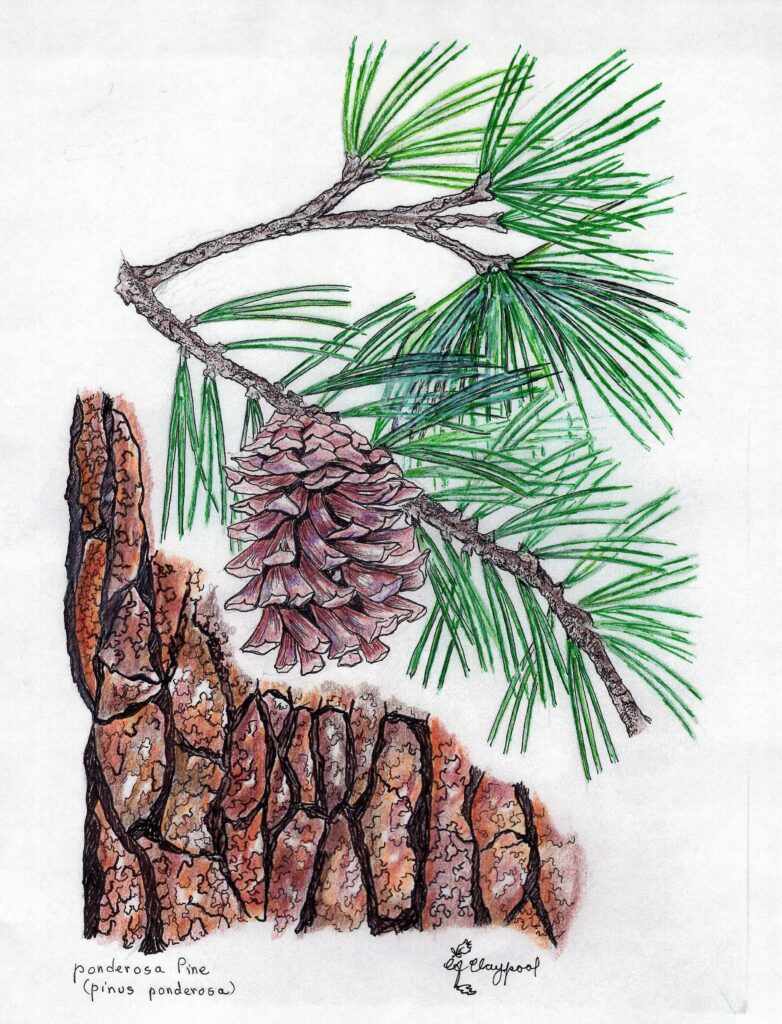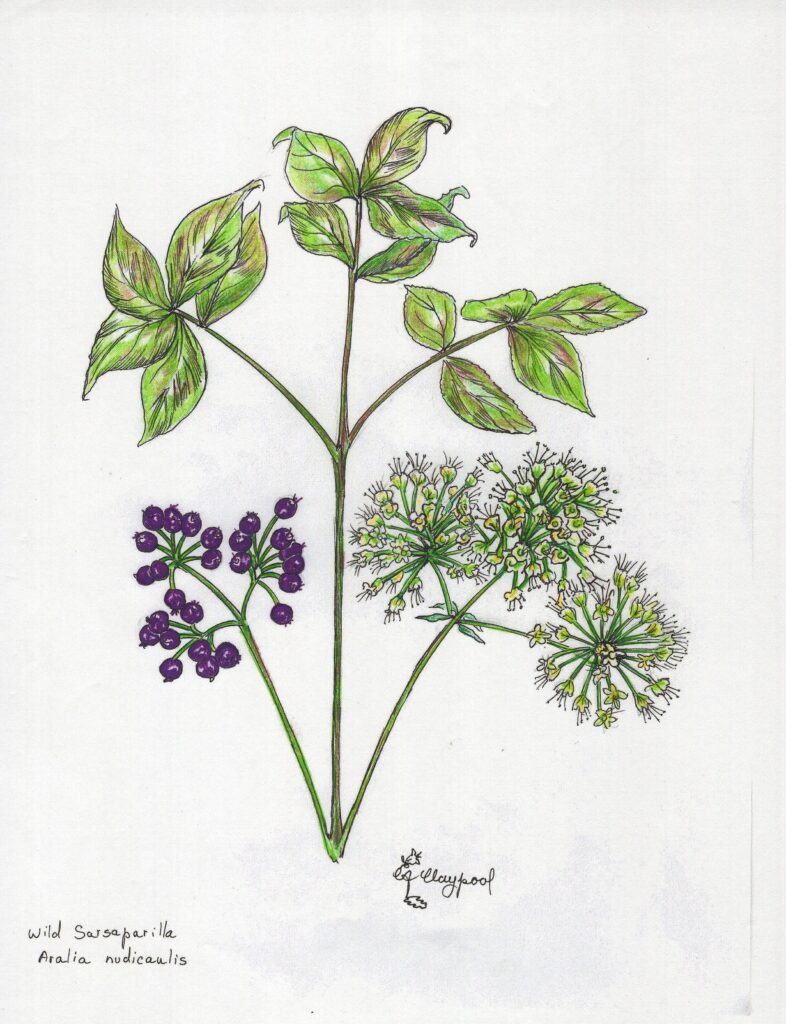Plant Index
Drawings by Carol Claypool
These drawings/images are the property of DEEEP Colorado. They may not be reproduced, distributed, or used for any purpose without express permission from DEEEP Colorado. Please view our copyright page for more information.
For a detailed list of additional information compiled by Terri Jamison and related to the plants shown below, please click here.
1. Antelope Brush (Purshia tridentata) Rose Family
This is a grayish shrub that reaches two to ten feet in height. The small pale yellow blossoms bloom from April to August. The leaves have three notched tips, are greenish gray, fuzzy on top and lighter color below. This was a forage food for livestock, and the bark was used by Native Americans to make moccasins and diapers for infants. The leaves have too bitter a taste to be used as food but do have medicinal uses as a tonic for fever, coughs and bronchial infections.
2. Fendler Barberry (Berberi’s Fendleri) Barberry Family
Fendler Barberry is a shrub that grows to eight feet tall. The edible berries have a flavor similar to tart cherries. Native Americans ate the berries raw and the stems were used for arrow making and basketry. The bright yellow flowers grow in clusters blooming in late spring. It was used to treat fevers and gum infections.
3. Rocky Mountain Bee Plant (Cleome serrulate) Capparaceae
Grows one to five feet tall with pink to white clustered flowers, with long stamens and seed pods. Native Americans used the seeds as food, eaten raw or cooked into a mush or stew, and also served as an antibiotic. Leaves were used medicinally as a blood pressure remedy or made into a tea for fevers. The flowers have four petals each and four sepals with six long stamens.
4a. Box Elder (Acer negundo) Maple Family
This species of maple can grow from fifty to eighty feet in height but under ideal soil conditions can reach one hundred fifty feet tall. It grows on most soil types and is common along streams, wetlands and river flood plains. Inner bark was medicinal and used to treat respiratory problems and kidney infections. Native Americans used the tree for firewood and the burnt charcoal for ceremonial painting. The sweet sap would have also been used by both Native and non-native people.
4b. Box Elder (Acer negundo) Maple Family
This species of maple can grow from fifty to eighty feet in height but under ideal soil conditions can reach one hundred fifty feet tall. It grows on most soil types and is common along streams, wetlands and river flood plains. Inner bark was medicinal and used to treat respiratory problems and kidney infections. Native Americans used the tree for firewood and the burnt charcoal for ceremonial painting. The sweet sap would have also been used by both Native and non-native people.
5. Prickly Pear Cactus (Opuntia polyaconyha) Cactus Family
There are many species of prickly pear cactus commonly found throughout the southwest in deserts, dry mountain slopes and grasslands. They spread out flat, spiny pads that are typically two to three inches wide and four to twelve inches tall and the blossoms can be any color but mostly reddish to yellow. The succulent fruits, blossoms and pads are edible and served as a food staple to Native Americans.
6. Common Cattail (Typha latifolia) Typhaceae Family
Cattail can grow to ten feet in height with brown to yellow or green flowers and dense 2-part spikes atop stout stalks. Leaves are long and narrow arising from the stalk base. They can be found in ponds, marshes, lakes, ditches and rivers. They are found across the continental USA. The starchy rhizomes were used by Native Americans as a food source, peeled and cooked or dried and used as flour. The young shoots were eaten raw or cooked, and the immature flower spikes were boiled and eaten. Leaves were not edible but used as weaving material and basket making. Cattails were used to feed the cattle as a survival food and grow abundantly throughout the southwest.
7. New Mexican Checkermallow (Sidalcea Neomexicana) Mallow Family
Checkermallow can grow up to 36 inches and the pinkish flowers look similar to a small hollyhock plant. Leaves on the upper plant are cut into segments as opposed to lower leaves which are more round. The leaves and blossoms are edible and Native Americans would have used them to make salads, soups and stews. A tea can be used as a digestive aid or to soothe a sore throat. Today Checkermallow is endangered, but back in the time of the expedition it would have served as a grazing food for cattle and livestock.8. Cliff Fendlerbush also False Mock Orange (Fendlera rupicola) Saxifrage Family
This shrub can grow up to ten feet, and the four petal blossoms are white but can be pink tinged. The bark is a reddish color but can turn more to gray in older plants. It’s usually found between 3000 to 7000 feet in most of the southwest on cliffs, canyon walls and dry locations. This would be considered a survival forage food for wildlife and domestic livestock, so the expedition may have used it as a cattle feed. Native Americans made use of the wood for arrow’s, ceremonial purposes, and insecticides. The inner bark was used as a gastrointestinal aid.
9. Golden Currant (Ribes aureum) Saxifrage Family
The shrub grows two to six feet tall with clusters of gold-yellow trumpet shaped flowers. Berries are about marble size and a yellow to reddish color but turn purple to black when ripe. They are found on hillsides and along creeks. The fruits are sweet and edible for both wildlife and humans. The dried fruit was mixed with dried buffalo or deer meat and fat to make a food ration called pemmican.
10. Dandelions (Taraxacum) Sunflower Family) (Officinale)
Dandelions were introduced from Europe by European settlers back in the mid-1600s, but since then have been used extensively by both early settlers and Native Americans as food, and the medicinal treatment for liver, kidney and digestive ailments. It is also used as a diuretic. All parts are edible, rich in nutrients and antioxidants and are eaten raw or cooked. They are easily recognized for their bright yellow blossoms and are found in a variety of environments and any soil types. Livestock grazed on dandelions as a food source.
11. Desert Evening Primrose (Oenothera primiveris) Evening Primrose Family
This beautiful flowering plant is a winter annual which grows to one foot tall and blooms in March, April, May and June. The large four petal flowers are either yellow or white and turn to a reddish color with age. The young leaves are edible cooked and Native Americans used the boiled roots as food or cough syrups, and the shoots are eaten raw. The seed oil is still used today as a woman’s tonic. The whole plant could be used as a poultice for bruises and wounds.12. Blue or Common Flax (Linum lewisii) Flax Family
Blue Flax can grow to be eighteen to twenty inches tall and can be found on dry slopes and ridges throughout the southwest and North America. It was named for Meriwether Lewis, the leader of the Lewis and Clark expedition. The flowers are pale blue with five petals and each stem produce’s several blossoms. Native Americans used blue flax fiber in rope making and the leaves and stems had use for stomach disorders and eye infections. The seeds may have been dried and used in cereals, flour, and bread making but since they contained cyanide, would require cooking before use. The plant may have been a forage for livestock.
13. Netleaf Hackberry (Celtis eticulata) Elm Family
This shrub can grow from twenty-five to forty feet tall and grows along canyons, streams and where water is present. Fruits are reddish in color and about ¼ inch in diameter, and were a food source for both Native Americans and wildlife. The brownish purple fruits are pea size, nutritious, contain protein and calcium and have a mild sweet flavor. The bark was used to make tea for colds and sore throats.
14. River Hawthorn (Crataegos rivularis) Rose Family
River Hawthorn can be identified by its small whitish blossoms, one-inch-long blackish curved thorns, and red to black small apple like fruits. The berries were dried, eaten or made into pemmican, but the seeds contained cyanide and are not edible. The whole plant is medicinal and often used for cardiac conditions. Native Americans also used the berries as a coffee-like beverage and the leaves were used as an alternative to tobacco. River Hawthorn can be found along the western slopes stream in the southwest.15. Field Horsetail (equisetum arvense)
This stocky plant grows one to two and a half feet tall and has whorls of branches at the joints. It survives in swamps, fields, woods, roadsides and riparian habitats and can be found growing throughout the southwest. Native Americans used it as a medicinal tea and as a diuretic and also a scouring utensil. Only the young shoots can be eaten raw or steamed for use as a wild vegetable. Today it is still used as a diuretic and also a bone strengthener for its silicon properties. It would have been edible to sheep and domestic livestock.16. Utah Juniper (Juniperus osteosperma) Cypress Family
Juniper which is common in the southwest grows ten to thirty feet tall on flats, slopes and mesas in poor dry soil. The trunk is short and berries are reddish brown to blue gray in color. The tree is mostly medicinal with the twigs, needles and cones used for medicinal teas for various ailments. Berries were boiled or dried for food although having a bitter taste. The seeds were used for beads and decoration.17a. Wild Licorice (Glycyrrhiza Lepidota) Legume Family
The plant can be found in disturbed environments over much of the Southwest and can grow to be from eight to forty inches. The five petal flowers are white to pale yellow. The roots, seeds and foliage serve as food for deer and other wildlife. The sweet roots are edible either raw or cooked but should be avoided by anyone with cardiac conditions. The plant’s sweet flavor is from the chemical glycyrrhizin which was originally used in the making of licorice candy. Native Americans used the plant to treat respiratory illness, rheumatism, and even as a flavoring for tobacco use. The leaves could be steeped and used to treat earaches. Cattle could have foraged on this plant.17b. Wild Licorice (Glycyrrhiza Lepidota) Legume Family
The plant can be found in disturbed environments over much of the Southwest and grows anywhere from eight to forty inches. The five petal flowers are white to pale yellow. The roots and seeds and foliage serve as food for deer and other wildlife. The sweet roots are edible either raw or cooked but should be avoided by anyone with cardiac conditions. The plants sweet flavor is from the chemical glycyrrhizin which was originally used in the making of licorice candy. Native Americans used the plant to treat respiratory illness, rheumatism and even as a flavoring for tobacco use.18. Sego Lilly (Calochortus nuttalli) Lilies Family
Sego Lilly, the state flower of Utah, has a deep growing edible bulb, a bit smaller than a walnut. It grows in dry sandy soil and blooms from May to July. The bulbs can be eaten raw, boiled or roasted and have a sweet nut-like flavor. The stem and white flowers are also edible and have a mild, nutty flavor. The plant is considered sacred to Native Americans. The Ute tribes dried the bulbs to preserve for winter use.19. Scarlet Globe Mallow (Sphaeralcea coccinea) Mallo Family
This mallow is a striking edible plant with deep red clustered flowers and narrow hairy leaves. Flowers have five petals and five sepals and grow up to sixteen inches in height. This plant is abundant in the southwest, growing in dry conditions on sandy soils and dry grasslands. Native Americans used the ground up plant as a poultice for wounds and burns, and the leaves have medicinal use as well. The whole plant was used as a food source and would also have been a grazing forage for domestic livestock.20. Manzanita/Bearberry (Arctostaphylos Uva-ursi) Heather Family KinniKinnik
This evergreen shrub has shiny green leaves, pinkish blossoms and bright red edible, but tasteless berries. It blooms from May through June and grows on rocky and bare ground throughout the Southwest. The bark is a reddish brown and can grow to eight to ten inches and forms mats. The berries were a food source for Native Americans and wildlife and remained on the branches through winter. The plant was medicinal and also used as a smoking tobacco. The leaves were used as a treatment for kidney and bladder problems and still used today as a medicinal herb.21. Mules Ears (Wyethia arizonica) Sunflower or Asteraceae Family
Mules Ears bloom from May to August and are found growing in clearings, meadows, stream banks and thickets. The flowers are yellow with long ray petals around a flat central disc. The leaves are fuzzy and clustered at the plants base. The plant can grow one to two feet tall. Seeds and stems are edible either raw or pounded into a flour called pinole. Native Americans could have made a poultice from the roots to treat blisters. Mules Ears prefer sandy soil and dry slopes.
22. Gamble Oak (Quercus gambelii) Beech Family
Deciduous tree found from 4000 to 8500 feet, usually on dry hillsides, slopes, canyons and mesas. It can grow to fifty feet tall and provided shelter, food and firewood. It was grazed upon by both wildlife and livestock. Acorns were used as a food source, leached in water to remove the tannic acid and ground into a meal for use as a porridge. Native Americans may have used the tannins as dyes or astringent for sore throats.23. Pinyon Pine (Pinus edulis) Pine Family
Pinyon Pine is the state tree of New Mexico. It can grow to 35 feet in height and has a reddish black bark with ¾ to 1½ inch dark green needles. It is gnarly and the female and male conelets are on the same tree. It grows on mesas, in canyons and on dry foothills. Pinyon is well known for the seeds or pine nuts, which provide food for wildlife, Native Americans and early settlers and is still used today. The wood bark was used for firewood and incense because of its fragrant aroma.24a. Willow Family
Cottonwoods exist in riparian habitat that must have its roots in the water table, and bear both male and female flowers on separate trees. Mature seeds from the female catkins are covered with white fuzzy cotton from which the name cottonwood is derived from. It usually grows between fifty to sixty feet tall but can also grow as tall as ninety feet. Uses are many: Native Americans used the wood to make bow drills, while the roots are used by the Hopis to carve kachina dolls. The Ute tribes held councils under the tree’s shade and the wood also could be used as firewood. The sap is sweet and edible both raw and cooked, and the young leaves and bark used as herbal teas. The leaf buds contain anti-inflammatory salicylates used to treat fevers and burns, and the inner bark is rich in vitamin C. They can be found in the Southwest along riverbanks, wetlands and streams.24b. Willow Family
Cottonwoods exist in riparian habitat that must have its roots in the water table, and bear both male and female flowers on separate trees. Mature seeds from the female catkins are covered with white fuzzy cotton from which the name cottonwood is derived. It usually grows between fifty to sixty feet tall but can also grow as tall as ninety feet. Uses are many: Native Americans used the wood to make bow drills, while the roots are used by the Hopis to carve kachina dolls. The Ute tribes held councils under the tree’s shade and the wood also could be used as firewood. The sap is sweet and edible both raw and cooked, and the young leaves and bark used as herbal teas. The leaf buds contain anti-inflammatory salicylates used to treat fevers and burns, and the inner bark is rich in vitamin C. They can be found in the Southwest along riverbanks, wetlands and streams.25. Fremont Cottonwood (Populus fremontii) Willow Family
All cottonwoods bear both male and female flowers on separate trees. Mature seeds from the female catkins are covered with white fuzzy cotton from which then named cottonwood is derived. It usually grows between fifty to sixty feet tall but can grow as tall as ninety feet. The sap is sweet and edible either raw or cooked. Leaves and bark can be used for herbal teas, and the root wood was used by the Hopis for carving Kachina dolls. The Ute tribes held councils under the shade of large cottonwoods. The leaf buds contained anti-inflammatory salicylates used to reduce fevers. Fremont cottonwood requires riparian habitat and must have its roots in the water table.26. Lanceleaf Cottonwood (Populus acuminata) Willow Family
This tree he can grow up to fifty feet tall with a diameter up to two feet. It is a fast-growing tree that can grow six feet in a year and have a life span of over 100 years. The leaves are long and slender and the seeds are attached to hair like follicles which look similar to a cotton ball and thus derived the name of cottonwood. Bark and leaves were used by Native Americans to treat wounds and provide firewood. The cotton-like seeds were used to stuff pads and pillows and the inner bark was used to make soap. The leaves are edible for humans as well as livestock.27. Prickly Poppy (Argemone pleiacantha) Poppy Family
Prickly Poppy is found throughout the southwest in disturbed areas and somewhat resembles a thistle. Flowers are large with white petals and yellow centers and bloom from late spring to autumn. The entire plant, although thorny, was used medicinally as a tea to reduce pain and as a sedative. Native Americans used the dried plant as an alternative to tobacco. This slightly toxic plant would be used topically but not as food for either humans or cattle.28. Desert Prince’s Plume (Stanleya pinnata) Mustard Family
This plant thrives in a desert environment and there’s a cluster of bright yellow flower spikes over bluish green foliage. It can grow to be thirty to sixty inches tall and blooms from late spring to early summer. Its habitat is dry prairies and desert scrubs. Native Americans used the leaves as a potherb when boiled in two changes of water, but toxic if eaten raw, as the plant gathers the mineral selenium from the desert soil. The root was crushed to a pulp and used as a poultice for toothache and painful gums and placed on the ear or throat to relieve pain. The flowers have four petals, four sepals and six stamens.29. Big Sagebrush (Artemisia tridentata) Sunflower Family
Sagebrush is extremely abundant in all of the southwest and grows between two and seven feet tall. Its habitat is the high deserts or plains and has silvery green hairy leaves, which are wedge shaped and highly aromatic. Because of its highly fragrant appeal, sagebrush was dried, bundled and used to make smudge sticks for ceremonies and used like incense. The smoke from the lit bundle was a means to purify oneself before sacred ceremonies. Sagebrush was used medicinally and also as campfire fuel. Cattle and sheep are able to browse on sagebrush as a food source when feed is scarce.30. Utah Serviceberry (Amelanchier Utahensis) Rose Family
This is a drought resistant shrub that grows from six to fifteen feet high, common in canyons and arid parts of foothills. It has clusters of white blossoms and purple hued blueberry like fruits which are sweet and edible. Native Americans used the berries as a food source either fresh or mixed with buffalo and venison meat and fat to make and store as pemmican. The berries were also eaten by numerous forms of wildlife and could have been a forage for livestock.31. Three leaf sumac or Lemita (Rhus trilobata) Sumac Family
This shrub has various common names including skunk bush, sumac and Sour berry. It grows from two to six feet tall on dry hillsides, canyons, plains, deserts and valleys. The flowers are tiny yellow and in summer will develop into edible but very sour bunches of small sticky red berries with a flavor similar to lemon. Native Americans dried the berries to make pemmican and used the stripped bark for basket making. The berries were also used as a lemonade-like beverage.32. Common Sunflower (Helianthus annus) Daisy Family
Sunflowers are common, easily recognizable, and can grow more than ten feet tall. They require six to eight hours of sunlight a day in order to thrive. The entire flower is edible. The plant has broad serrated edged leaves, a coarse fuzzy stem and the flower head has yellow petals and a dark round center disc made up of many small flowers. Native Americans and non-Natives made use of the entire plant. The seeds are edible, raw, cooked, or pounded into flower for bread. The seed oil is used even today. The plant is medicinal and also used for dyes, ceremonies and building materials. Today this plant is a popular ornamental as well as providing a healthy snack.33. Tomatillo or Pale Wolfberry (Lycium palliclum) Night Shade Family
Tomatillo or little tomato is a spiny shrub that can grow to six feet but average is closer to three feet. It has pale greenish gray leaves and small yellow green trumpet-like blossoms. Fruits are marble size and edible, but bitter and even in times of shortage is either fresh or dried. The fruits were eaten by birds and animals and are still used today to make salsa and sauces.34a. Narrow Leaf Yucca (Yucca angustissima) Agavaceae Family
Yucca blooms up to about six feet tall and is native to the southwest. Flowers, seeds and fruits are edible but should be boiled first. The leaves are thin and needle-like and were used by Native Americans for weaving mats and baskets. Yucca has been used for osteoarthritis, joint pain and other conditions. The stems, trunks and roots contained saponins which are toxic, but can be used as soap and shampoo. The large bell-like flowers are whitish in color.
34b. Narrow Leaf Yucca (Yucca angustissima) Agavaceae Family
Yucca blooms up to about six feet tall and is native to the southwest. Flowers, seeds and fruits are edible but should be boiled first. The leaves are thin and needle-like and were used by Native Americans for weaving mats and baskets. Yucca has been used for osteoarthritis, joint pain and other conditions. The stems, trunks and roots contained saponins which are toxic, but can be used as soap and shampoo. The large bell-like flowers are whitish in color.
35. The Quaking or Trembling Aspen (populus Tremuloides) Willow Family Salicaceae
The Quaking Aspen deciduous tree can grow from 50 to 80 feet tall and has bright green three-inch-long sawtooth edged leaves that turn a golden yellow in autumn. The tree usually grows in thick groves which are easily identified by its cream color, pale gray-green bark. Quaking Aspen gets its name from the fluttering or trembling motion the leaves make in the breeze. It is native to north America and can usually be found at elevations from 5,000 to 10,000 feet. It is the state tree of Utah. The bark is eaten by moose, elk, deer and beavers who also use it to build dams. The shoots serve as forage for cattle, sheep and goats. Native Americans used the bark as a medicine similar to quinine and also used the inner bark, catkins, sap and seeds for food sources and medicinal properties. The bark contains salicylic acid, a source of natural aspirin, and used as a remedy to treat pain. The wood was used by the Ute tribes in the making of teepees, shelters and lodge construction. The Utes also carved glyphs representing significant events onto the bark and considered the Aspen as a medicine tree and one of their sacred trees.36. Chokecherry/Wild Cherry (Prunus virginiana) Rose Family Rosaceae
Chokecherry is native to North America and grows from ten to fifteen feet tall along stream and riverbanks, forests, woodlands, rocky slopes and roadsides. It can be found in elevations from 4,500 to 9,000 feet. The name was derived from the sourness of the fruit maybe causing people to choke if not prepared for the taste. The blossoms are whitish in color with five petals and bloom in May. The leaves are two to four inches long and the dark red to purple fruits have a long list of uses including wine, jellies, syrup and pie making. Native Americans used the fruits for food pemmican and as a medicine for stomach ailments. Tart cherry is popular today as a treatment for arthritis and anti-inflammatory. Chokecherry made an excellent flavor for cough syrup, wine and antioxidant as they are loaded with Vitamin C. The bark and pits contain a substance that releases cyanide when crushed so would have been avoided. The inner bark was made into a tea to treat diarrhea and respiratory illness. Extracts of the inner bark was used as an astringent to be applied topically to wounds and abscesses. The fruits also served as food for wildlife especially loved by bears.37. Trumpet Gooseberry (Ribes leptanthum) Currant Family
Trumpet gooseberry, in the same genus as currant, is native to the southwest. It can be distinguished from the currant by its larger berries and often has thorns on the stems, while currants do not. It grows in sunny dry areas at elevations from 5,500 to 12,000 feet, usually about three feet tall but can reach as tall as six feet. The white to pinkish blossoms have five petals and the berries are dark purple to black when ripe. The berries have a sour taste when green but turn sweeter when ripe and are edible by wildlife and humans. Both birds and bears find them appealing as forage, and they are a good source of vitamin C, vitamin A, potassium and manganese. Native Americans used the berries to make pemmican, jams, jellies and tea. The leaves and flowers were made into poultices for skin infections and the Navajos used the woody stems to make arrow shafts. The roots were used for cordage.38. Ponderosa Pine (Pinus Ponderosa) Pine Family Pinaceae
Ponderosa Pines can be found in all of Western North America at elevations of 5,000 to 9,500 feet on dry mountain soils, hillsides and foothills. The tree also known as Western Yellow Pine can grow anywhere from 150 to 180 feet tall, be three to four feet in diameter and live to be 300 to even 500 years. It is native to mountainous regions in western states. The taproots grow deep into the soil to utilize needed moisture. The needles on branch ends are five to ten inches long and in clusters of 3 but can be two. The thick bark is a blackish color when the tree is young but turns an orange brownish hue as the tree matures and has a scaly texture with a slight fragrance of vanilla. The wood is well known for its use in making furniture, construction materials and firewood. Native Americans made use of the inner bark as an edible food either raw or cooked. The raw seeds served as a food source for birds and wildlife.39. Wild Sarsaparilla (Aralia nudicaulis) Araliaceae Ivy Family
Wild Sarsaparilla is native to North America and associated with the popular soda, Root Beer. It grows in sunny, dry or moist climates in elevations anywhere from 5500 to 12,000 feet. It is also found in shady Colorado woodlands in rich soil. It can reach five to sixteen inches tall with one eighth inch wide flowers divided into three groups of five toothed leaflets. The flower clusters are a cream white color and the fruits, originally green, turn to reddish green and when mature, a deep dark purple. They have a sweet mild flavor and were used by Native Americans to make jellies, pemmican and beverages. The plant grows on a stalk with three branches of leaves. The roots, berries and young shoots are edible and traditionally the rhizomes were used for making root beer. Native Americans used the plants as food and medicine, including the young cooked roots. A tea made from the rhizomes served as a remedy for toothaches, sore throats, cardiac and stomach problems.


